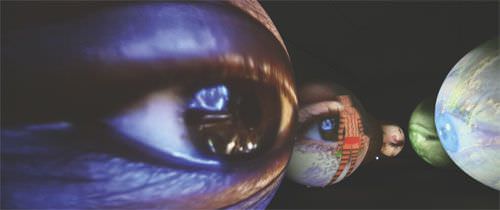
The Fondation Cartier pour l’Art Contemporain: Tony Oursler – Mirror Maze (Dead Eyes Live), 2003
Situated at the confluence of art and industry, employing very high-level designers and artisans, watchmaking is an industry unlike any other. It produces objects that are, of course, extremely technical, yet their design is essential. A watch is, at the same time, a minuscule machine and a piece of jewellery. What’s more, the relationship that a person has with his or her watch, far from being anonymous and impersonal, is, on the contrary, the embodiment of specific emotions that are evoked by a unique object (even if it is mass produced).
This stems as much from a symbolic relationship (after all, a watch counts our own time, which is the only ‘thing’ that we truly possess), as it does from the care and personal attention that each timepiece receives during its elaboration and manufacture (and the more the watch approaches the realm of Haute Horlogerie, the more personalized it becomes).
The domain of the arts is radically different from other human endeavours in that it only proposes unique ‘objects’. A book, a film, a theatrical play, a sheet of music, a painting… these are all unique in and of themselves. They are situated in a precise era which influences them, and which in turn is influenced by them. The best among these pieces will transcend their time and epoch to enter into a form of universality and timelessness. Thus the arts are indifferent to the idea of progress (a prehistoric painted horse on a cave’s wall in Lascaux, France is neither ‘better’ nor ‘less good’ than a painting by Picasso; they are equal). Yet the arts are not indifferent to the idea of transmission, the transmission of knowledge, techniques, and an outlook on the world.
For watchmakers, whose raw material is time and who skilfully create objects that, for the best among them, are destined to survive their owner and transcend their era, the relationship between what they do and the concept of art is thus quite a natural one.
In this vein, a number of watch brands are patrons of the arts and culture with a focus on the collective ‘patrimony’ of humanity, the ‘transmission’ of knowledge, and the ‘expression’ of an era.
The Rolex Mentor and Protégé Arts Initiative: giving time
“Giving the essence of one’s own existence: time.” With this expression, Patrick Heiniger, General Manager of Rolex SA, defines Rolex’s program of artistic patronage. The offer of time, the time to allow potential young artists to benefit from the help and advice of a recognized master in their field, is the basis of Rolex’s philanthropic activity, perhaps the only one of its kind in the world.
Rolex launched its international program of artistic patronage in 2002, and each cycle runs one year. It covers six artistic disciplines: dramatic art, visual art, literature, dance, music, and film. In each of these fields, Rolex invites a recognized master to serve as the Mentor, who will give advice and instruction to the Protégé, a person with promising talent who has not yet reached their full potential. The program of this one-on-one personal relationship is established by each Mentor who decides, along with the Protégé, how their collaboration will work. A minimum of six weeks of work together is expected during each cycle of the year, but it is clear that each discipline will have different specifications.
No concrete result is expected at the end of the cycle, no exhibition or book or film is required. The basic idea of the project is to give the Protégés the freedom, in terms of space time and space, to grow and to mature in their art form.
Some of the principal objectives of Rolex’s patronage are to create a Master/Student link, to encourage the transmission of cultural patrimony, and to advance the exchange between generations. During their time in the Mentor/ Protégé relationship, the artists are not subjected to any pressure.
A very important goal of this program is also to promote the interdisciplinary nature of the various art forms. During each cycle, a series of meetings are conducted among the different Mentors and their Protégés in order to encourage dialogue between the disciplines. In the same vein, the program is gradually opening to the community in the form of public meetings and discussions between Mentors and Protégés. One example is an event held in New York City in December 2005, in collaboration with Columbia University.
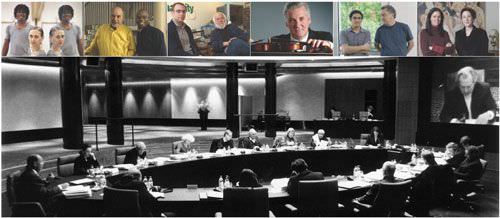
Above: Portraits from the 2006/2007 cycle: Anne Teresa De Keersmaeker, Mentor, and Anani Dodji Sanouvi, Protégé / Tahar Ben Jelloun, Mentor, and Edem Awumey, Protégé / John Baldessari, Mentor, and Alejandro Cesarco, Protégé / Pinchas Zukerman, Mentor / Stephen Frears, Mentor, and Josué Mendez, Protégé / Julie Taymour, Mentor, and Selina Cartmell, Protégé
Advisory Board Members of the Rolex Mentor and Protégé Arts Initiative
Pina Baush, Tahar Ben Jelloun, Trisha Brown, Peter Carey, Carolyn Carlson, Christo and Jeanne-Claude, Alain Coblence, Alfonso Cuaron, Guy Darmer, Ariel Dorfman, Martin T. Engstroem, William forsythe, Jonathan Galassi, Franck Gehry, Amitav Gosh, Gary Graffman, Paul Gottlieb, Cynthia Gregory, Agnes Gund, Sir Peter Hall, Geraldina James, Joseph Kalichstein, Anish Kapoor, Harvey Liechtenstein, Cho-Liang Lin, Sir Neville Marriner, Joseph Melillo, Yoko morishita, Elizabeth Murray, Ivan Nabokov, Mira Nair, Jessye Norman, Michael Ondaatje, Gabriel Orozco, Julia Peyton-Jones, Carlos Saura, Valerie Solti, Wole Soyinka, Julie Taymor, Robert Wilson.
A very important organization
While it is Rolex SA, headquartered in Geneva, which is responsible for the program, the watch enterprise has created a special department to oversee the details. Made up of around fifteen people, this department is under the leadership of Rebecca Irvine, who also supervises the Rolex Awards for Enterprise. The management of the Rolex Mentor and Protégé Arts Initiative is carried out with the seriousness that characterizes all of Rolex’s undertakings.
The task of choosing the Mentors falls to an Advisory Board, made up of influential individuals from the world of arts, under the direction of Patrick Heiniger. (The list of Advisors is below.) The board, which is independent and testifies to the credibility and objectivity of the program, meets at the beginning of each cycle to select the Mentors from among the most respected personalities on the international artistic scene. They are all not only recognized as a Master in their specific discipline but they also, and above all, have a real desire to assure the transmission of their art, and thus are willing to devote time and energy to the program.
Once the Mentors are chosen, the hunt begins for the most promising artistic talents around the world. Potential candidates cannot apply. All selections are carried out by anonymous nominators, who recommend the names to Rolex, which in turn contacts the nominees, who must send in examples of their work. The watch brand will constitute dossiers for each candidate and then send them to a number of experts in each discipline. At this stage, three or four finalists will be named, who will then meet the Mentors. The final selection of the Protégé is determined by the Mentor in each category.
As part of the program, each Protégé receives a stipend of US$ 25,000, plus travel expenses, and each Mentor receives US$ 50,000. Besides this financial investment, Rolex also supports the growing careers of its Protégés in various ways. But, what is most important for the watch enterprise is to encourage exchange and the transmission of a state of mind, activities that go way beyond mere commercial or marketing considerations.
The Fondation Cartier pour l'Art Contemporain
Contemporary art and luxury, according to Cartier, is “a marriage that was almost written in heaven,” says Bernard Fornas, CEO of Cartier. He quickly adds that, “Luxury with a big ‘L’ and contemporary art go together because, for both, it is a question of creativity and audacity.”
This marriage is due to the vision of Alain- Dominique Perrin, who created the Fondation Cartier pour l'Art Contemporain in 1984, following the suggestion of the French painter and sculptor, César. Interestingly, everything began because of counterfeiting. In 1981, Cartier won a court case against a Mexican national of French origin who had opened fourteen fake Cartier stores in Mexico. Perrin then decided to symbolically have all the fake Cartier watches smashed to bits under a steamroller, making a big media splash. Since he was also interested in contemporary art, he thought about creating a foundation to help protect the intellectual property of artists who, unlike Cartier, do not have the means to attack those who usurp their creations. In 1983, Perrin invited César to make one of his famous compressions with a pile of fake watches. César explained to Perrin that, rather than helping artists to defend their rights, it would be more important to offer them the opportunity to “create unusual projects, to establish an exhibition space that would be free and original.” So, the Fondation Cartier pour l'Art Contemporain was born. In the beginning, it was located near Paris, where artists could come and live, but in 1994, it moved to the heart of the city, occupying a magnificent building designed by the architect, Jean Nouvel.
In two decades, the foundation has made a name for itself on the international artistic scene as one of the hauts lieux of contemporary art creativity. Its bold, eclectic, and often avant-garde public exhibitions have appealed to a wide range of visitors, and have also contributed to the discovery of major artists. From painting to video, including photography, design and fashion, all artistic disciplines have their place in the displays that bring together artists, both known and unknown.
Since its founding, Alain-Dominique Perrin has imposed a clear distinction between the brand and Cartier products on one side, and the foundation on the other. With the single exception of the mention of Cartier in its title, all Cartier products and marketing are rigorously excluded from the foundation. “I want to maintain the foundation’s autonomy, its independence, its freedom,” Perrin said in a 2004 interview. “To mix the genres would be an error. The Fondation Cartier is a work of true philanthropy. However, Cartier does receive media benefit from it, which is intelligently orchestrated. But I do not want people to mix the creations of Cartier, which is a company of applied arts and business, with art that comes to us, seeking a space of liberty.”
“Luxury, it is that, too,” confirms Bernard Fornas, “and not only to make three handbags. The foundation is an integral part of Cartier’s image. It is a complement to the brand itself, but it must have its own and absolute autonomy. Of course, the clientele of contemporary art and Cartier products are often the same, but the results are difficult to quantify. They are of the order of reputation, appreciation, and recognition. They are not at all directly commercial.”
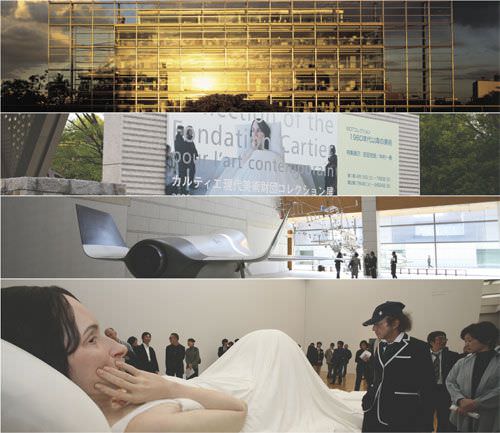
Above: The Fondation Cartier pour l’Art Comtemporain in Paris, designed by Jean Nouvel
Below: The Fondation Cartier pour l'Art Contemporain in Tokyo
Marc Newson – Kelvin 40, 2003, Ron Mueck – In Bed 2005
A large collection
Besides organizing major exhibitions of its collections both at home and abroad (one example is the very important exposition held at the Contemporary Art Museum in Tokyo, the MOT, which attracted 100,000 visitors), an essential activity of the foundation is commissioning its artistic creations. Since 1994, it has commissioned more than 70 works or ensembles. But, the foundation’s activity is not limited solely to being a patron of the arts; it accompanies the creation, from concept to realization, and then supports the career of the budding artist. In addition to its direct commissions, the foun-dation has gradually put together a very large collection – more than 1000 works from 300 artists – that retraces the major trends of artistic creation on an international level. This collection is even more important since “its vocation is strictly artistic and not in the least speculative,” insists Bernard Fornas, who sits on the foundation’s board, made up also of celebrated personalities from the world of culture and the arts. Cartier remains, however, quite silent concerning the foundation’s budgets for operations and acquisitions. The organ-ization’s future seems quite assured, though, since Johann Rupert, the head of Cartier within the Richemont group, is himself a knowledgeable collector of contemporary art.
Jaeger-LeCoultre, photography and film
For the last two or three years, Jaeger-LeCoultre has increased its backing of the arts by supporting two art forms that have a direct relationship to time: photography and film. “A brand such as ours, which is in the luxury sector,” explains Isabelle Gervais, the brand’s International Public Relations Manager, “naturally feels close to the artistic universe because we understand both the practices and the issues. A manufacturer such as Jaeger-LeCoultre, with its numerous designers and artistic skill sets, possesses a creative dimension comparable to that of artists themselves. We are not far from sharing the same reasoning. The patronage of the arts, by bringing us closer to the artistic world, nourishes us in return, enriches us. As you know, our manufacture operates by its individual ateliers. These different workshops are constantly proposing new ideas, and carrying out their own research with the goal of always going farther. And, within this framework, the relationship that we have with the artists stimulates the ensemble of our procedures and each of our collaborators.”
A concrete example of this close relationship is the recent collaboration of Jaeger-LeCoultre with the Musée de l'Elysée, which specializes in photography. For its 20th anniversary, the Musée de l'Elysée launched a vast exposition called ReGeneration. This project showcased 50 young photographers from around the world, selected by the best international schools, and representative of all the latest trends - the ‘greats’ of tomorrow, in a manner of speaking. Closely associated with this exhibition, Jaeger-LeCoultre invited 16 of them to spend a few days at the manufacture and to photograph it as they saw fit. At the conclusion of their visit, a book was published, with images offering an unbiased and often inno-vative look at the ateliers, as well as the men and women who work there. These same photographers were also exhibited in the ateliers themselves, in order to create a direct relationship between the artists and the employees of Jaeger-LeCoultre. The watch brand also supported locally the work of these young artists.
Following this compelling activity, the brand decided to extend its support for the art of photography on a more institutional level, and formed a long-term partnership with the famous Parisian museum, Jeu de Paume. It is a purely cultural patronage, “for which we do not expect any direct return on investment,” explains Isabelle Gervais, “but it is an activity that we feel is in line with our image of being creative.” This foray into photography also involves commissioning works by recognized photographers, such as the recent Polaroid portraits of all the employees at Jaeger-LeCoultre, shot by the Italian photographer, Mauricio Galimberti, or other images realized by Douglas Kirkland to describe the “voyage of a watch” through five continents.
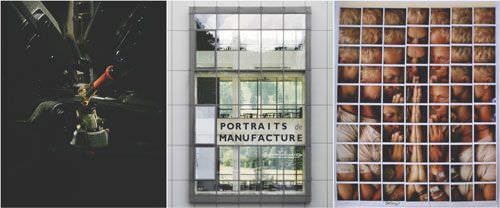
A selection of pictures from the book Portraits de Manufacture by Jaeger-LeCoultre
Restoring the cinematographic patrimony
It is in this same spirit of cultural patronage that Jaeger-LeCoultre approached the world of film. “We wanted to go beyond the ‘product placement,’” declares Isabelle Gervais, “beyond the glitter and glamour of the obvious, to look at film with the same serious resolve that marks all of our actions. In 173 years of existence, we have learned the capital importance of patrimony, material as well as non-material. The transmission of our heritage, knowledge, and practices - our flame, in a way - is essential, and is a daily reality in our manufacture.” It is thus completely logical that Jaeger-LeCoultre should support the restoration of the patrimony of the art of cinema, of films that have constituted its history.
In collaboration with the Biennial of Venice and the Cinema Museum in Turin, Jaeger-LeCoultre participated in the restoration of the film Il Feroce Saladino, a film phenomenon of the 1930s, contemporary with the birth of the brand’s Reverso timepiece, and which testifies to the early years of the actress, Alida Valli. The brand’s vocation of restoring patrimonial films is continuing and, during the Venice Film Festival which took place this last September, the brand concluded an agreement with a group of celebrities (including Juliette Binoche, Scarlett Johansson, Sting, Sandra Bullock, Oliver Stone, Ben Alfeck, and others) to create a special Reverso timekeeper engraved with the star’s name, which would be sold at auction, with the proceeds going to restore old films.
But, just because it is a patron of the arts, doesn’t mean that Jaeger-LeCoultre neglects, however, the more glittery or more directly glamorous side of cinema. In Venice, the Swiss brand not only gave the special Reversos to the various winners of the main awards, but in Rome in January, it will also present the “Movie Stars Jaeger-LeCoultre Award” to the photographer who best covered the event. It enjoyed a strong presence, incarnated by the white tent that the brand had erected in the middle of Nikki Beach, the most popular place at the Festival, where celebrities could come and admire the Jaeger-LeCoultre’s most beautiful timepieces, or like Catherine Deneuve, President of the Jury, they could come and choose their jewels. It is clearly an intelligent way to link the serious cultural patronage of the arts to the promotion of its products.
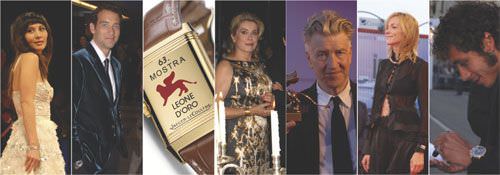
From left to right: Josie Ho, Clive Owen, the Special Reverso made for the Mostra, Catherine Deneuve, David Lynch, Stefania Rocca, Valentino Rossi
Louis Vuitton Foundation
Bernard Arnault, CEO of the LVMH Group, recently took Paris by storm with the unveiling of plans for a Louis Vuitton Foundation dedicated to contemporary art. A maquette for a glass Foundation building was presented by the Californian architect, Frank Gehry, who is best know for the Guggenheim Museum in Bilbao. The project will be entirely funded by the LVMH Group and is projected to cost a hundred million euros over four to five years. Two to three big exhibitions will be organised each year.
Source: Europa Star October-November 2006 Magazine Issue





